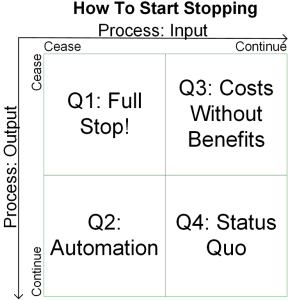This week I will be going into an operational planning meeting. Like most of the operational planning meetings I have attended, three questions are being asked:
- What do we want/need to start doing
- What do we need to continue to do or finish and
- What should we STOP doing?
The first two questions are relatively easy to answer and there is a plethora of information on How, Why, When, Where and What to plan. In this blog, I want to focus on the Stop question, specifically:
What does “Stop” Mean in the Context of Operational Planning?
How Many Stops have been Really Stopped?
In my career, I have been in dozens of planning meetings and I cannot really recall something identified as ‘should be Stopped’ that was actually stopped. At the same time, over my career, I have stopped doing many things that I used to do with out the ‘thing’ being part of a planning meeting. Why is it so hard to identify a process to stop and then actually stop it?
Stopping to Define A Process
A quick stop for a definition and in this case the word ‘Process’ which is one of these wonderfully loaded terms. Fortunately the good folks at the International Standards Organization can help: (source: http://www.iso.org, ISO 9000:2015; Terms and Definitions, 3.4.1, accessed 2016-04-02):
3.4.1 process: set of interrelated or interacting activities that use inputs to deliver an intended result (Note 1 to entry: Whether the “intended result” of a process is called output (3.7.5), product (3.7.6) or service (3.7.7) depends on the context of the reference.).
Assuming that an organization wants to stop a process, the challenge of doing so is built into the definition – when you stop something, you must deal with the inputs, the outputs and the impact on the inter-relation between potentially numerous activities.
Starting to Use a Process Focused Way of Stopping
Fortunately the above definition also gives us a methodology to evaluate what processes we can stop, change or that we are stuck with. The Process Focused Way of Stopping uses a 2 x 2 matrix which asks two simple questions: will Inputs or Outputs Cease or Continue? Inside the resulting matrix is a gradient between the extremes of fully stopping or continuing to deploy inputs and outputs. The four themed quadrants can help an organization understand the challenges and execution of stopping a process and interrelated impacts on the organization of doing so.
The Four Quadrants of Stopping
Or how to manage the “Law of Unintended Consequences“.
- Full Stop!:
- Inputs Stop, Outputs Stop
- Business Example: Nokia, formerly a pulp and paper company that evolved into an electronics/cell phone company.
- Organizational thoughts: abandoning or decamping from a process.
- Risks/challenges: if a downstream process requires the output, a new and not necessarily better process may spring up to fill the void
- Automation:
- Inputs Stop, Outputs Continue
- Business Example: Automation of airline ticketing and reservation systems over the past 40 years.
- Organizational thoughts: automation is central to productivity enhancements and cost savings.
- Risks/challenges: over automation can backfire, for example, being able to talk to a human is now seen as premium support for a product instead of simply directing customers to a website or a phone response system.
- Costs Without Benefits (Yikes!):
- Inputs Continue, Outputs Stop
- Business Example: A mining company paying for site remediation long after the mine has been closed.
- Organizational thoughts: Generally this is the quadrant to avoid unless there is a plan to manage the risks and downside costs (e.g. a sinking fund).
- Risks/challenges: Organizations may land here as a result of the Law of Unintended Consequences..
- Status Quo:
- Inputs Continue, Outputs Continue
- Business Example: any company that stays the course in their product line; this includes companies that should have changed such as Kodak.
- Organizational Thoughts: this is a typical reaction when asked to changed processes. Lack of organizational capacity and willingness to change supports general inertia.
- Risks/challenges: As Kodak discovered, a lack of willingness to internally cannibalize and prune an organization may lead to external forces doing it for you.
How to Start Using a Process Focused Way of Stopping?
‘So What?’, how can this model be used? At a minimum I plan to bring it with me to the next planning session and when someone identifies an activity to ‘STOP’ I will point to the quadrant the thing falls into. This is not to prevent good organizational design, new ideas or planning; but it is to focus on the practicalities of planning and execution.
Hopefully you can start using this Stopping Model the next time you begin a planning meeting!

